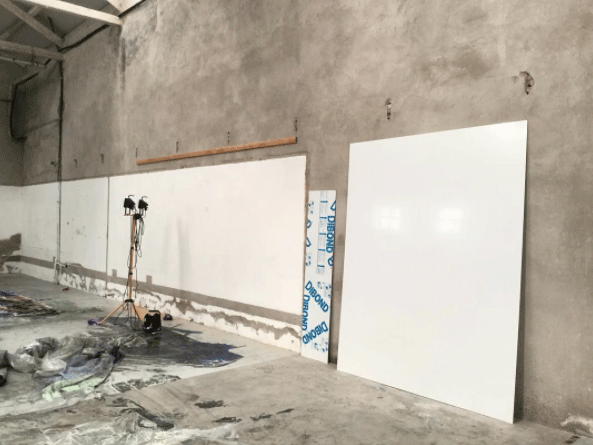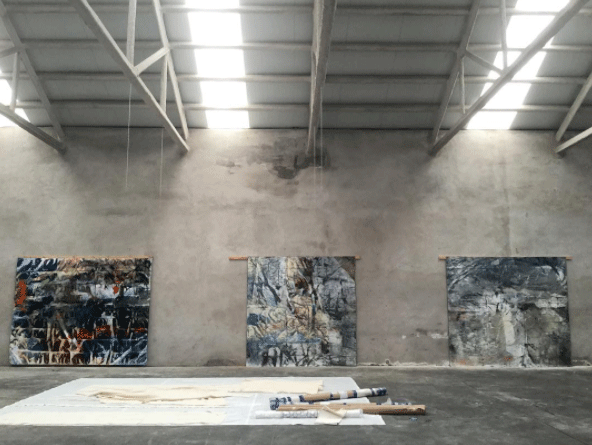 In the artist’s studio 10’x7’ sheets of Dibond aluminum composite material are positioned for prep and paint. King Farish is the artist in residence at his Los Angeles space embarking on a new series and possibly seeking show opportunities in the future. Farish is a self-taught artist and photographer originally from Oklahoma City, Oklahoma. He spent 16 years in Alabama before venturing onto street photography in Chicago in 2000. Then, five years later Farish picked up a paintbrush to begin a new medium of expression.
In the artist’s studio 10’x7’ sheets of Dibond aluminum composite material are positioned for prep and paint. King Farish is the artist in residence at his Los Angeles space embarking on a new series and possibly seeking show opportunities in the future. Farish is a self-taught artist and photographer originally from Oklahoma City, Oklahoma. He spent 16 years in Alabama before venturing onto street photography in Chicago in 2000. Then, five years later Farish picked up a paintbrush to begin a new medium of expression.
Dibond aluminum composite was chosen for the new series primarily because it is a lightweight substrate that is strong, rigid, and has the ability to hold paint unlike other materials such as wood. The material features two pieces of aluminum sandwiched around a polyurethane core that gives Dibond a reliable surface to work from, while maintaining a lightweight quality. It is also considered a museum-grade substrate that can be easily mounted in a gallery setting or showcased outside. Wood on the other hand is heavy and warps under some paint processes. Since Farish works with wet onto wet, wood would have problems warping and holding moisture.
 The artist’s process begins by first cradling the back of the flat panel with aluminum angles. The outer surface is lightly sanded and wiped down with rubbing alcohol. Next, the artist prepares the piece with a combination of gesso, Golden Artist Colors 800, and Golden matte medium. These primers are useful tools for extending color and decreasing gloss. This process is then repeated to create a primary layer that is extremely adhesive.
The artist’s process begins by first cradling the back of the flat panel with aluminum angles. The outer surface is lightly sanded and wiped down with rubbing alcohol. Next, the artist prepares the piece with a combination of gesso, Golden Artist Colors 800, and Golden matte medium. These primers are useful tools for extending color and decreasing gloss. This process is then repeated to create a primary layer that is extremely adhesive.
When not creating on Dibond, the artist paints on white poly tarps, which are much less stable. The same technique is applied to cloth-like tarps as the Dibond, but they tend to lose some of the paint in the process and drip paint strokes in hushed natural colors on the white tarps becomes part of the paintings. The artist likes that the creases in the plastic tarps create a typography when paint is applied. In order to create a more architectural structure on the Dibond, the artist builds up the surface with various materials and a thick application of paint to create a two-dimensional starting point. While the artist will continue to work with the white tarps, Dibond offers a much more stable surface to work from while still maintaining an adhesive surface for paint.
Most of King Farish’s works are abstract grids of colors that play with light and dark. While there is no show slated at this time for the new series, there are a lot of opportunities for upcoming exhibits in the works.
Information and photography courtesy of King Farish

